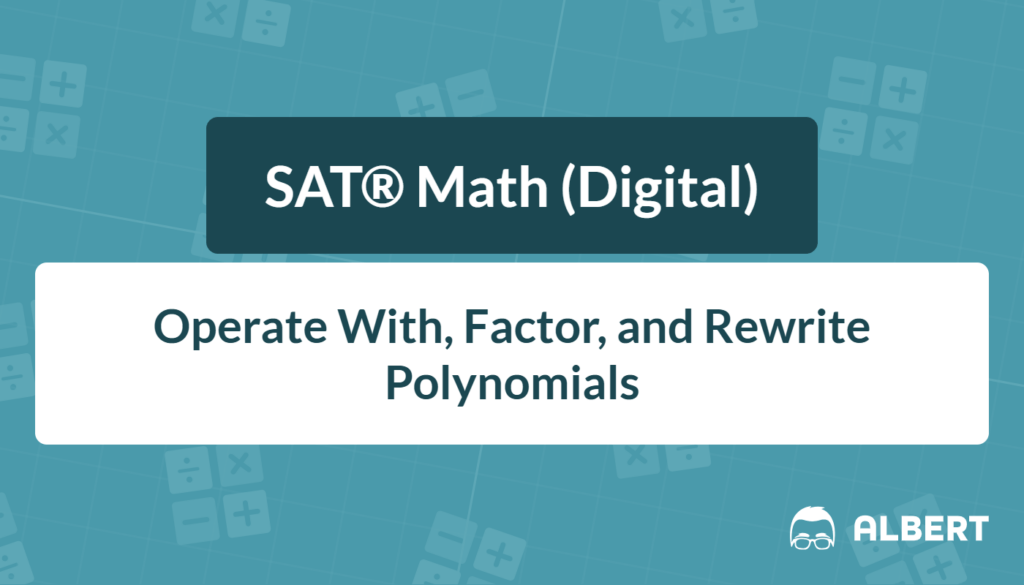What We Review
Introduction
Every SAT® Math test features polynomials. Therefore, being fluent in operations with polynomials (adding, subtracting, multiplying, and factoring) saves precious minutes. This guide explains the core moves, shows step-by-step examples, and provides quick strategies so that rewriting polynomials feels automatic on test day.
Why Polynomials Matter on the SAT®
Roughly one out of every six SAT® Math questions relies on polynomial structure. Sometimes you must identify an equivalent expression; other times you must simplify a rational expression or solve an equation. However, the underlying skill is the same: recognize patterns and use algebraic properties to rewrite expressions quickly.
Foundations First: Polynomial Vocabulary
A. What counts as a polynomial?
A polynomial is a sum of terms where each term is a constant multiplied by a non-negative integer power of the variable. No negative or fractional exponents appear.
B. Key parts
- Degree – highest exponent
- Term – each separated piece (e.g., 4x^2)
- Coefficient – a number multiplying the variable
- Constant – a term with no variable
C. Leading coefficient & standard form
In standard form, terms are written from highest to lowest degree. The coefficient in front of the first (highest-degree) term is the leading coefficient.
Mini-Check
Identify the parts of 3x^2-5x+7:
- Degree: 2
- Leading coefficient: 3
- Constant: 7
- Middle term coefficient: −5
Basic Operations with Polynomials
A. Adding & Subtracting
Always line up like terms—terms with the same variable and exponent.
Example
Add (4x^2+3x-2)+(2x^2-5x+6).
Step 1: Combine x^2 terms:
4x^2+2x^2=6x^2Step 2: Combine x terms:
3x-5x=-2xStep 3: Combine constants:
-2+6=4Therefore, the sum is 6x^2-2x+4.
B. Multiplying
i. Distributive Property (monomial × polynomial)
Multiply 3x(2x^2-5x+4).
Multiply 3x by every term in the parentheses.
3x(2x^2)+3x(-5x)+3x(4)=6x^3-15x^2+12x
ii. Multiply binomials by multiplying every term in one set of parentheses by every term in the other set
| Step | Reason |
|---|---|
| (x + 2)(x - 3) | Original expression |
| x(x - 3) + 2(x - 3) | Use distributive property |
| x^2 - 3x + 2x - 6 | Distribute both terms |
| x^2 - x - 6 | Use the distributive property |
iii. Special Products
- Square of a binomial: (a+b)^2=a^2+2ab+b^2
- Difference of squares: (a+b)(a-b)=a^2-b^2
Example
Compute (x+7)^2.
Using the formula: x^2+2(7)(x)+7^2=x^2+14x+49
Result: 4x^2-28x+49
Factoring: Turning a Mess into a Product
A. Factoring out the Greatest Common Factor (GCF)
Always look for a GCF first; doing so often simplifies further steps.
Example
Factor 12x^3-18x^2+6x.
The GCF is 6x. Therefore, 12x^3-18x^2+6x=6x(2x^2-3x+1).
B. Factoring Trinomials ax^2+bx+c
i. Simple trinomials (a = 1)
Factor x^2+7x+10.
Find two numbers that multiply to 10 and add to 7 → 5 and 2.
So, (x+5)(x+2).
ii. Advanced trinomials (a ≠ 1) – “AC” method
Factor 6x^2+11x+4.
Step 1: Multiply A and C (A is the leading coefficient and C is the constant)
6\cdot4=24Step 2: Find two numbers that multiply to 24 and add to 11 → 8 and 3.
Step 3: Factor by grouping.
| Step | Reason |
|---|---|
| 6x^2 + 11x + 4 | Original expression |
| 6x^2 + 8x + 3x + 4 | Rewrite the middle term using 8 and 3 |
| (6x^2 + 8x) + (3x + 4) | Group terms |
| 2x(3x + 4) + 1(3x + 4) | Factor each group |
| (3x + 4)(2x + 1) | Final factored form ✅ |
C. Special Patterns
- Difference of squares: a^2-b^2=(a+b)(a-b)
- Sum of cubes: a^3+b^3=(a+b)(a^2-ab+b^2)
- Difference of cubes: a^3-b^3=(a-b)(a^2+ab+b^2)
Example
Factor x^4-81.
First, notice x^4=(x^2)^2 and 81=9^2; therefore it is a difference of squares.
x^4-81=(x^2+9)(x^2-9).However, x^2-9 is again a difference of squares:
x^2-9=(x+3)(x-3).Final answer: (x^2+9)(x+3)(x-3).
D. Factoring Speeds Up Solving Quadratic Equations
Solve x^2-5x+6=0 by factoring.
- Factor: x-2(x-3)=0
- Zero Product Rule gives x=2 or x=3.
- Therefore, the quadratic is solved without a calculator or quadratic formula.
Rewriting Polynomials & Rational Expressions
A. Radicals and Rational Exponents
Remember, \sqrt[n]{x}=x^{1/n}. Therefore, converting forms can simplify multiplication.
Example
Rewrite \sqrt[3]{x^5} in rational-exponent form:
x^{5/3}.B. Simplifying Rational Expressions by Factoring
Example
Simplify \dfrac{6x^2-15x}{3x}.
Step 1: Factor the numerator: 3x(2x-5).
Step 2: Cancel the common factor 3x with denominator 3x.
Result: 2x-5.
Therefore, recognizing common factors keeps the work short.
Strategy Section: Choosing the Right Tool on Test Day
Certain SAT® phrases signal the required operation.
- “Equivalent form that reveals zeros” → factor.
- “Expanded form” or “standard form” → multiply.
Moreover, watch for perfect-square or difference-of-squares patterns; spotting them avoids heavy algebra. Finally, keep mental math sharp by memorizing squares up to 15^2 and cubes up to 5^3.
Quick Reference Chart: Must-Know Vocabulary
| Word | Definition | SAT® Tip |
| Polynomial | Sum of terms with non-negative integer exponents | Ensure no variables in denominators or radicals |
| Degree | Highest exponent in the polynomial | Shows the maximum number of roots |
| Coefficient | Number multiplied by a variable | Zero coefficient means term is absent |
| GCF | Greatest common factor of all terms | Factor it out first to simplify |
| Factor | Expression multiplied with another to produce a product | Used to reveal zeros quickly |
| Expand | Rewrite as a sum instead of a product | Often done by FOIL or distribution |
| Rational Expression | Fraction whose numerator and denominator are polynomials | Always factor first when simplifying |
| Radical | Expression containing a root symbol | Convert to exponents for easier manipulation |
| Exponent | Indicates repeated multiplication | Follow power rules for simplification |
| Like Terms | Terms with identical variable parts | Only these can be added or subtracted |
Practice Question Set
Try these three mini SAT®-style problems.
- Expand and simplify: (2x-1)(x+4)
- Factor completely: 8y^2-18y+9
- Simplify: \dfrac{x^2-16}{x+4}
Solutions
- 2x^2+7x-4
- (2y-3)(4y-3)
- x-4
Final Takeaways & Next Steps
Mastering Operations with Polynomials transforms many SAT® questions into quick wins. Therefore, practice each skill until spotting patterns feels natural. Next, set a timer for 10 minutes and drill five factoring problems daily. For more targeted practice, explore SAT® Math study guides and full-length tests that focus on polynomial operations.
Unlock those points—one factor at a time!
Sharpen Your Skills for SAT® Math (Digital)
Are you preparing for the SAT® Math (Digital) test? We’ve got you covered! Try our review articles designed to help you confidently tackle real-world SAT® Math (Digital) problems. You’ll find everything you need to succeed, from quick tips to detailed strategies. Start exploring now!
Need help preparing for your SAT® Math (Digital) exam?
Albert has hundreds of SAT® Math (Digital) practice questions, free response, and full-length practice tests to try out.









